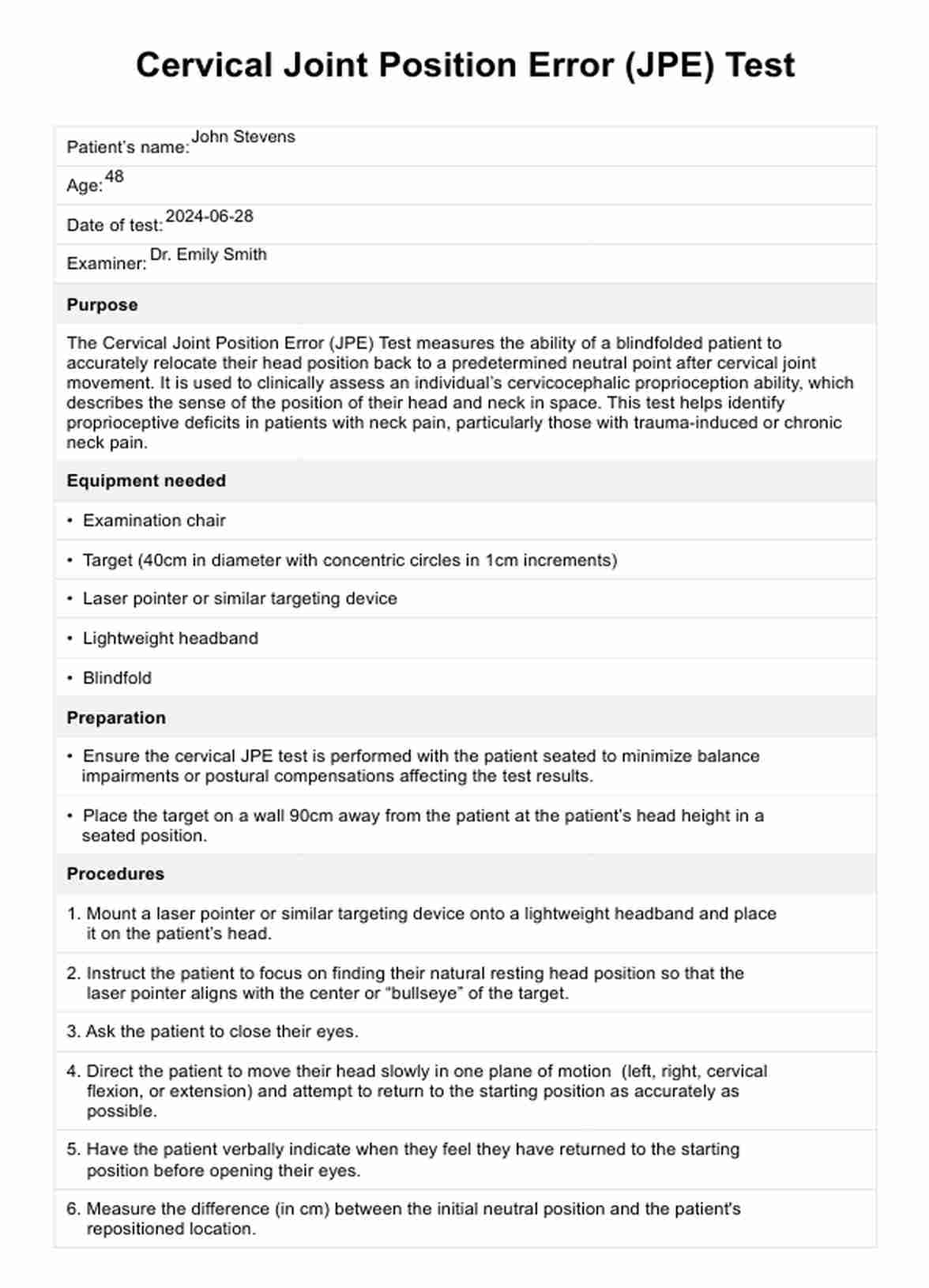Cervical Joint Position Error Test
Optimize patient care with our Cervical Joint Position Error Test template. Accurate, efficient, and standardized documentation for better outcomes. Download now!


What is the Cervical Joint Position Error Test?
The Cervical Joint Position Error (JPE) Test is a clinical assessment tool used to evaluate an individual’s cervicocephalic proprioception, or their ability to sense the position of their head and neck in space. This test measures how accurately a person can return their head to a predetermined neutral position after movement. It is important for diagnosing proprioceptive deficits in patients with neck pain, whether the pain is from traumatic injuries like whiplash or has a gradual onset.
Healthcare professionals use the Cervical JPE Test for patients experiencing chronic neck pain, dizziness, or balance issues. The test helps identify sensorimotor control disturbances and is also helpful in rehabilitation settings to track recovery progress and adjust treatment plans accordingly.
Cervical Joint Position Error Test Template
Cervical Joint Position Error Test Example
How to use our Cervical Joint Position Error Test template
Carepatron's free printable Cervical Joint Position Error Test template allows you to conduct the test and document results in minutes. Follow these steps to get started:
Step 1: Download and prepare the template
Download a copy of our Cervical Joint Position Error Test template. This template will guide you through recording patient information, conducting the test, and noting the results. Ensure all necessary equipment is ready, including an examination chair, target, laser pointer, headband, and blindfold.
Step 2: Prepare the patient
Instruct the patient to sit comfortably in the examination chair. Place a target on the wall 90 cm away from the patient at their head height. Secure the laser pointer onto the headband and place it on the patient’s head. Explain the procedure to the patient, ensuring they understand the purpose and steps of the test. Allow the patient to find their natural resting head position, aligning the laser with the center of the target.
Step 3: Conduct the head movements
With the patient blindfolded, ask them to move their head in one plane of motion (left, right, cervical flexion, extension, etc.). After the movement, instruct the patient to return to the starting position as accurately as possible. The patient should verbally indicate when they believe they have returned to the starting position before removing the blindfold.
Step 4: Measure and record the displacement
Measure the difference between the laser beam's position on the target at the test's start and end. Record the displacement in centimeters. Repeat the test at least three times for each direction of motion assessed. Ensure the patient re-centers their starting position and rest before each trial.
Step 5: Analyze the results
Convert the displacement measurements into degrees using the formula provided in the template. Then calculate the average from both the measures in centimeters and degrees to get the overall result. If the directional error is over 4.5 degrees or more than 7 cm from the bullseye, the patient is considered to have a proprioceptive deficit.
Results and interpretation of the Cervical Joint Position Error Test
The Cervical Joint Position Error Test assesses proprioceptive impairments by measuring the difference in centimeters between the starting and finishing positions of a laser pointer on a target. This difference is then converted into degrees of error, providing a precise evaluation.
As mentioned, the test is repeated at least three times, and the mean error is calculated to get the overall results:
- Positive test: If the average directional error is over 4.5 degrees or more than 7cm from the starting point, this indicates proprioceptive deficit
- Negative test: If the average directional error is under 4.5 degrees or less than 7cm from the starting point, this indicates that there is no proprioceptive deficit.
The results of the Cervical Joint Position Error Test can provide valuable information for healthcare professionals in diagnosing and treating patients with neck pain or injuries. It allows for a more objective assessment of proprioceptive function and can aid in determining the effectiveness of treatment interventions.
However, further testing and evaluation may be necessary as the results of the test can also be influenced by other factors such as muscle strength, range of motion, and joint stability.
Benefits of using our template
Our Cervical Joint Position Error Test template offers numerous advantages for healthcare professionals. Here are three key benefits:
Standardized documentation
Our template ensures that all necessary information is captured consistently, enhancing the accuracy and reliability of the test results. This standardized approach helps maintain comprehensive records for each patient, facilitating better tracking of their progress over time.
Time efficiency
Our template saves healthcare professionals valuable time by providing a clear and structured format. It eliminates the need to create documentation from scratch, allowing practitioners to focus more on patient care and less on administrative tasks.
Enhanced patient care
With all relevant details systematically recorded, healthcare professionals can make more informed decisions regarding treatment plans. This leads to improved patient outcomes as the template aids in the accurate diagnosis and effective management of proprioceptive deficits.
Commonly asked questions
Cervical joint position error (JPE) is a measure of cervicocephalic proprioception, or the sense of head and neck position in space. The cervical JPE test assesses a person's ability to accurately relocate their head to a neutral position after cervical movement.
The Cervical Joint Position Error Test assesses an individual's proprioception ability, specifically the sense of position of the head and neck in space. It helps identify proprioceptive deficits, particularly in patients with neck pain due to trauma or chronic conditions.
Healthcare professionals should develop a rehabilitation plan focusing on cervical proprioception exercises if a patient shows significant proprioceptive deficits. Regular follow-up assessments are recommended to monitor progress and adjust the treatment plan.






































































































